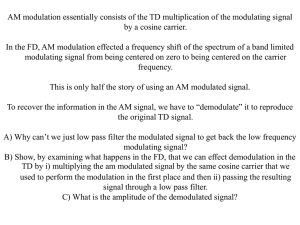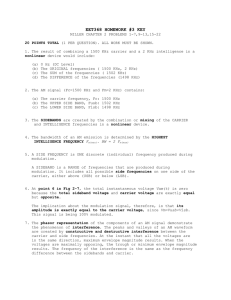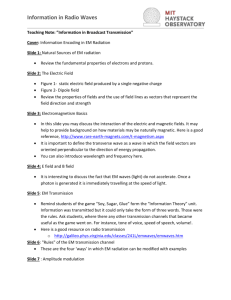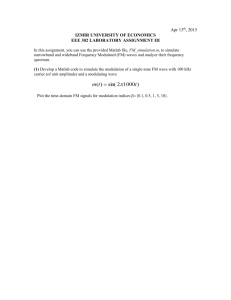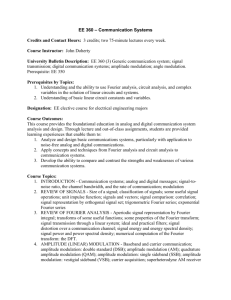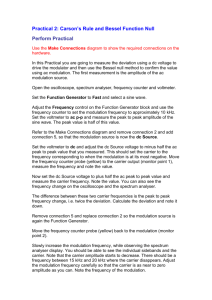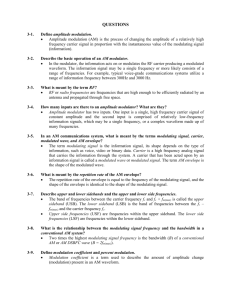Tutorial 2 answer
advertisement
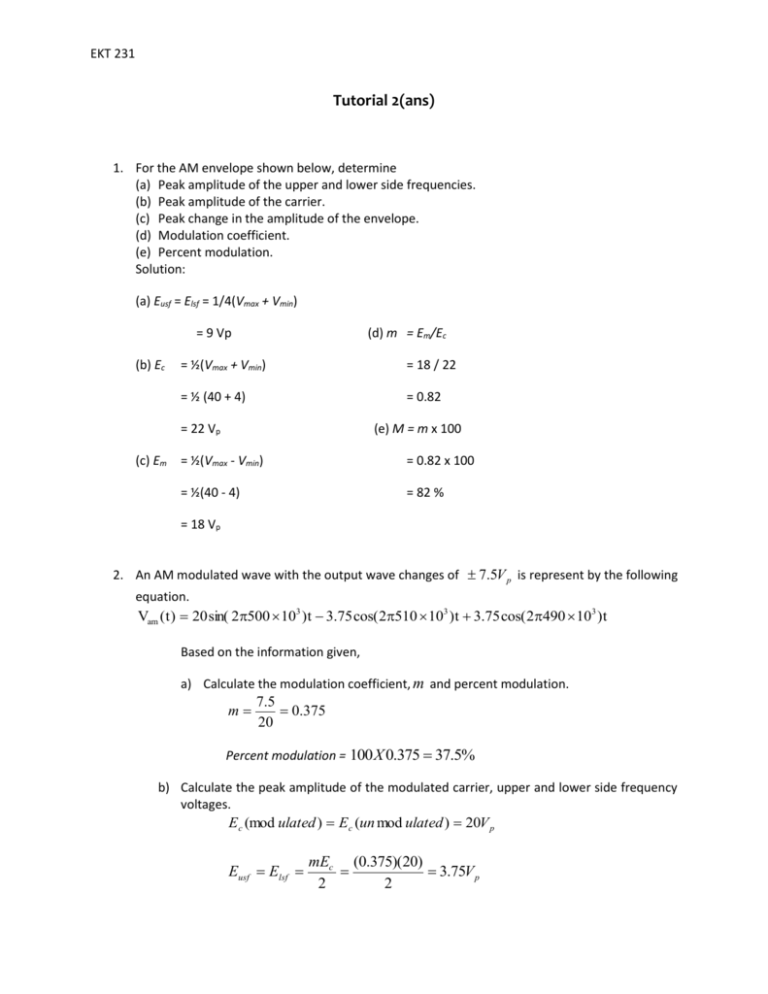
EKT 231 Tutorial 2(ans) 1. For the AM envelope shown below, determine (a) Peak amplitude of the upper and lower side frequencies. (b) Peak amplitude of the carrier. (c) Peak change in the amplitude of the envelope. (d) Modulation coefficient. (e) Percent modulation. Solution: (a) Eusf = Elsf = 1/4(Vmax + Vmin) = 9 Vp (b) Ec (d) m = Em/Ec = ½(Vmax + Vmin) = 18 / 22 = ½ (40 + 4) = 0.82 = 22 Vp (c) Em (e) M = m x 100 = ½(Vmax - Vmin) = 0.82 x 100 = ½(40 - 4) = 82 % = 18 Vp 2. An AM modulated wave with the output wave changes of 7.5V p is represent by the following equation. Vam ( t ) 20 sin( 2500 103 ) t 3.75 cos( 2510 103 ) t 3.75 cos( 2490 103 ) t Based on the information given, a) Calculate the modulation coefficient, m and percent modulation. m 7.5 0.375 20 Percent modulation = 100 X 0.375 37.5% b) Calculate the peak amplitude of the modulated carrier, upper and lower side frequency voltages. Ec (mod ulated ) Ec (un mod ulated ) 20V p Eusf Elsf mEc (0.375)(20) 3.75V p 2 2 EKT 231 c) Calculate the maximum and minimum amplitude of the envelope. Vmax Ec E m 20 7.5 27.5V p Vmin Ec E m 20 7.5 12.5V p d) Draw and label the frequency spectrum. e) Sketch and label the output envelope. 3. A commercial AM station is broadcasting with an average transmitted power of 10 kW. The modulation index is set at 0.707 for a sinusoidal message signal. Find the following: (a)The average power in the carrier component of the transmitted signal. (b) The transmission power efficiency Solution: (a) Pt=Pc (1+ m2/2) 10kW= Pc(1+ (0.707)2/2) Therefore, Pc= 8kW (b)Power efficiency is the power at side bands = (10kW- 8kW)=2kW Therefore, (2kW/10kW)X 100%=20% 4. For an AM DSBFC envelope with a +Vmax = 40 V and +Vmin = 10 V, determine a) Unmodulated carrier amplitude. b) Peak change in amplitude of the modulated wave. c) Coefficient of modulation and percent modulation. Solution: (a) 1 𝐸𝑐 = 2 (𝑉𝑚𝑎𝑥 + 𝑉𝑚𝑖𝑛) =25Vp EKT 231 1 (b) 𝐸𝑚 = 2 (𝑉𝑚𝑎𝑥 − 𝑉𝑚𝑖𝑛) =15Vp 5. One input to an AM DSBFC modulator is an 800-kHz carrier with an amplitude input is a 25-kHz modulating signal whose amplitude is sufficient to produce a + 10 V change in the amplitude of the envelope. Determine (a) Upper and lower side frequencies. (b) Modulation coefficient and percent modulation. (c) Maximum and minimum positive peak amplitudes of the envelope. (d) Draw the output frequency spectrum. (e) Draw the envelope (label all pertinent voltages). Solution: a) fUSF = fc + fm (b) m fLSF = fc - fm = 800 + 25 = 800 - 25 = 825 = 775 = Em/Ec M = m x 100 = 10 / 40 = 0.25 x 100 = 0.25 = 25% (c) V(max) = Ec + Em V(min) = Ec - Em = 40 + 10 = 40 - 10 = 50 = 30 6. An antenna transmits a 10kW power at 95% modulation using conventional AM. Determine the amount of power saving if Single Side Band (SSB) transmission is used for the same intelligibility. Given Pt = 10kW, m = 0.95 Conventional AM: Pt = Pc + PUSB + PLSB EKT 231 m2 m2 m2 Pc Pc Pc 1 1.45125Pc 4 4 2 10 103 Pc Pc = 6890.61W SSBSC AM: m2 m2 0.95 2 PSSBSC PSB Pc (6890 .61) 1554 .69 W 4 4 4 Power Saving Pt PSSBSC 10x103 1554.69 8445.31W % Power Saving = 8445 .31 10 x10 3 x100 % 84 .45 % 7. An 800 kHz sinusoidal carrier signal is amplitude-modulated by a 5 kHz audio signal to produce an AM envelope with maximum and minimum peaks voltages of 120Vp and 30Vp respectively. The transmitting antenna has an equivalent resistance of 75Ω. Based on the given information, a. Determine peak amplitude of the audio, carrier and sidebands voltages. Vc Vmax Vmin 75Vp 2 Vm Vmax Vmin 45Vp 2 Vusb / lsb Vm 22 .5Vp 2 b. Calculate the bandwidth of the modulated signal. BW = 2fm (max) = 2 x 5 kHz = 10 kHz c. Calculate the power of the carrier signal and total sidebands power. 2 Pc Vc 37.5W 2R Ptotalsb m 2 Pc (0.62 )(37.5) 6.75W 2 2 EKT 231 d. Sketch and label the power spectrum of the modulated signal. 8. For an AM Double Side Band Full Carrier (DSBFC) wave with an unmodulated carrier of 25Vp and a load resistance of 50Ω, determine the unmodulated carrier power, modulated carrier power, upper and lower sideband powers and total transmitted power for a modulation index, m = 0.6. Given Vc = 25Vp and R = 50Ω 2 Pc(unmod) = Pc (mod) = PUSB = PLSB = Vc 252 6.25W 2R 2 50 m2 0.62 Pc (6.25) 0.5625W 4 4 Pt = Pc + PUSB + PLSB = 6.25 + 2(0.5625) = 7.375W 9. One input to an AM DSBFC modulator is a 500-kHz carrier with a peak amplitude of 32 V. The second input is a 12-kHz modulating signal whose amplitude is sufficient to produce a +14 Vp change in the amplitude of the envelope. Determine the following: (a) Upper and lower side frequencies. (b) Modulation coefficient and percent modulation. (c) Maximum and minimum amplitudes of the envelope, Then (d) Draw the output envelope. (e) Draw the output frequency spectrum. Solution: a) fUSF = fc + fm = (500 + 12) kHz = 512 kHz (b) m = Em/Ec fLSF = fc - fm = (500 – 12) kHz = 488 kHz M = m x 100 = 14/32 = 0.4375 x 100 = 0.4375 = 43.75% (c) Vmax = Ec + Em Vmin = Ec - Em EKT 231 = 32 + 14 = 32 - 14 = 46 Vp = 18 Vp 10. For the same value given in question 9, determine bandwidth, total power of the modulated wave, the percentage power saved compare to AM DSB-FC and draw the power and frequency spectrum for the following: a. AM DSB-SC b. AM SSB-FC c. AM SSB-SC 11. There are two methods of generating AM Single Side Band (SSB) which are filtering method and phasing method. Explain in details each of the method.


